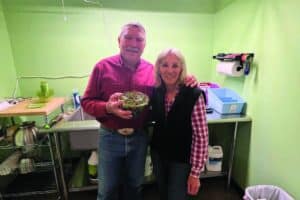Colorado is presently in a drought. In the past 20 years, the state experienced a drought in 2002, 2012 and 2018; with 2019 declared drought free.Becky Bolinger, assistant state climatologist and research scientist II at the Colorado State University Colorado Climate Center, said a drought is a prolonged period of abnormally low rainfall, leading to a shortage of water. She said Colorado has the added benefit of the snowpack in the mountains instead of being solely reliant on groundwater. ìThe whole state to some extent relies on the snowpack in the mountains for their water supply,î Bolinger said. ìWhen there are winters without much or at least not enough to replenish the reservoir supply through the spring and summer, then we know we may be looking at drought conditions.îShe said the problems leading up to this drought started in the spring of 2020. ìThe snowpack was OK in some areas but it melted too fast and too early, so it didnít fill up the reservoirs the way we like. That started the drought, and it intensified through the summer and fall,î she said. ìBecause of that, 100% of the state is in drought conditions.îBolinger said to get out of this drought, Colorado needs above average snowpack to make up all the deficits from last year. The first deficit is that reservoirs did not fill up last spring; and, because of a hot, dry summer, extra demands were put on those reservoirs, dropping their levels even more, she said.The lack of moisture from the monsoons that Colorado receives July through September created another deficit. Bolinger said Southern Colorado usually gets good monsoon moisture, but this has been lacking for the last four years. The last deficit concerns the soil, which is currently very dry. She said in the mountains, if the soil is dry then the snowpack will initially soak into the ground, which means extra snowpack is needed to run off into the rivers and ultimately fill the reservoirs. ìWeíre in a situation where not only do we need a normal snowpack because we need that every year, but we need a lot more to chip away at these deficits,î she said. ìIf we donít have this, it just takes longer to get out of drought conditions. At this point, it doesnít look like we have enough to get us out of the drought.îBolinger said the big snow months for Coloradoís Front Range happen in March and April, but the snow accumulation in the mountains needs to be more evenly distributed from December through February. ìIdeally, we want the snowpack to keep building until April; melting slowly into the soil, out to the river and into the reservoirs from mid-April to June,î Bolinger said. ìWe want it to keep adding to the reservoir until June; if it melts out by May or mid-May then the reservoirs donít get the full benefit.îEffects of draught on gardeningIrene Shonle, Ph.D., horticulture associate at Colorado State University Extension El Paso County, said the state of Colorado has activated the municipal portion of its emergency drought plan for 2021; this is only the second time in history it has been implemented. She said it is part of the State Emergency Drought Plan; each city has its own drought response.Shonle said if residents plan to have a vegetable garden this summer, work with the soil so it sufficiently holds water by adding organic matter such as compost or aged manure. She said the recommendation is to add 2-to-3 inches of organic matter on top of the bed for every 6-to-8 inches gardeners dig underground ó and then thoroughly mix it in. Use a drip irrigation system as opposed to hand-watering or overhead sprinklers; that way the water only goes to the plant, she said.Plant vegetables in blocks instead of the traditional row, and plant more compactly rather than having a big sprawling garden, Shonle said. The leaves of the plant will protect the soil plus gardeners will get more produce in a small space. Add mulch on top of any open soil or empty spaces to keep the soil from getting too dry and to control weeds, she said. Other suggestions for mulch include weed-free straw, crushed-up dry leaves from fall or spring rake-up and fine mulch (not big chunks). She said gardeners can use pine needles or grass but make sure they arenít in clumps as that tends to keep water from getting to the soil.Aerate lawns in the spring to prevent thatch and promote healthy roots, which is important all the time, but especially during a drought, Shonle said. Early morning watering is better; watering during the heat of the day just evaporates instead of getting to the plants. Monitor where the water is going; if itís running off the lawns, it is either being over-watered or not going where it is meant to go, she said.Grant Winger, executive director of the Fresh Start Center in Colorado Springs, said they have a garden on the property that is used to provide produce for their clients. He said they have 42 5-by-10-foot raised beds on 1-and-a-half acres.Winger said they learned plenty from last yearís dry growing season. ìIt was an uphill battle last year, but weíre in a constant state of learning,î he said. ìWhen we first started our garden, we had sprayers, but we changed to drip irrigation to be more focused and conservative with the water we have, and our resources.î He said this year, theyíre also going to focus on plants that donít require as much water. ìOur goal is to have zero waste and the most productive outcome as possible. We check, adjust and move forward accordingly, and use our resources as efficiently as possible,î Winger said.






